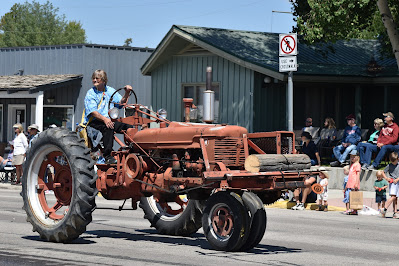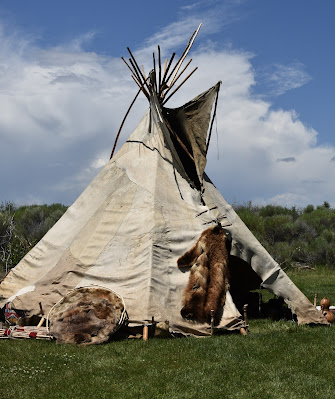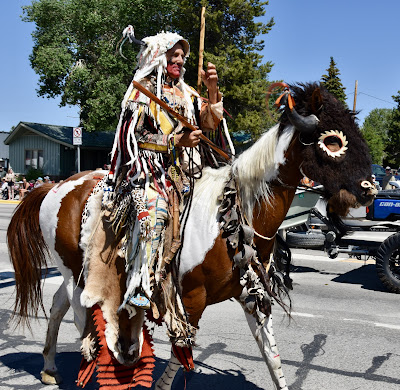Art, natives, pioneers
Musings as we depart Pinedale, Wyoming, and set our sails toward Thermopolis.
I dreamed last night that my garden at home was decimated by the heat Prescott is experiencing. I felt sad about it, as if something was lost that can never be regained, but then isn’t that the truth of every passing minute. What we are, and what we have at any given moment is really all there is.
Since my first time in Wyoming in 2017, I have wished to return. I am enchanted by the state, with its expanses of high plains marked spectacularly by mountainous miles that draw tourists from all over the world.
That trip allowed us views of twisting steep canyons cut through rock, rivers & streams cascading down from snowy peaks to become placid watery meanders across sage plains, a land populated by multitudinous pronghorn herds left me wanting more. Now I am experiencing more of what this alluring country has to offer, and enjoying every minute.
Certainly, the majority of Wyoming visitors are concentrated in a very few places, leaving hundreds & hundreds of miles unnoticed and unremarked. In general, that slowly revolving windmill alone on otherwise tedious sage-dominated rolling hills that we just passed as we traverse a two-lane highway would be of little interest to passers-by, if noted at all. To me, though, it evokes thoughts of the ranchers who pioneered this region, who stayed despite bitter winters and howling summer storms, who worked and continue to live on and love this land.
They each have a story, as unique as the genes that combined to make all of us who we are. I won’t know all their stories, but I do feel our kinship as humans who are making our way as best we can.
Doyle in Jackson . . .
Not of Wyoming, but now celebrated at a prestigious art gallery in Jackson, at least - our nephew Doyle Hostetler is making a name for himself in the world of wildlife artistry. Through absolutely no prior planning on our part, we found ourselves camped near enough to Jackson that we were able to attend the opening reception of his solo art show at Gallery Wild.
It required enough of a drive that we opted to make a day of it. Admittedly, it was a bit shocking after two weeks of Wyoming’s expanses and little-trafficked byways to land in the popular tourist mecca of Jackson.
Shifting mental gears, we inched into a coveted parking spot, and set off on the boardwalks that are a hallmark of that downtown tourist haven. A nice lunch outside, and then we walked through a historic residential district that is being destroyed in the quest to make room for out-of-towners and their dollars.
We enjoyed a small shaded park - the town square - that was dedicated in 1932 as a George Washington Memorial Park. . .
. . . and that was adorned at each of its four corners with gigantic aches made completely from elk antlers and built by the Jackson Hole Rotary Club. The antlers were shed by the approximately 7,500 elk that winter on a nearby refuge. Antlers are collected each spring by Boy Scouts and sold at public auction at the park.
A handsome veterans memorial got my attention, even more when I saw the only name listed as having served in the War of 1812: David Edward Jackson.
Jackson - hmm - the light bulb went off and I found the call of research irresistible. Not surprisingly, the very man for whom the town is named was one of the trio of mountain men, with William Sublette & Jedidiah Smith who operated a fur trading company: Smith, Jackson & Sublette.
As a free trapper, Jackson often returned to a particular valley in the Tetons where he had established his own trapping territory, so often that Sublette dubbed it Jackson’s Hole. I had wondered about that terminology, and now I know whence it came.
Before the anticipated art show reception, we perused another gallery that we thoroughly enjoyed, at least until the señor leaned on (“brushed against” was his take) an absurdly expensive tall box thing that was touted as a sculpture, and caused it to tilt precariously. The gallery attendant and he righted it quickly before damage was incurred, thus we are not required to sell our house in compensation.
A few other sights around town got our attention.
Finally, it was time for Doyle’s show, so we met with him & Charla to bask in his reflected glory, and to lend family support.
I include photos of some of his pieces, astounding work by any measure, even more so from a self-taught artist of only a short duration. They speak for themselves.
Pinedale doin's . . .
We quickly came to love Pinedale, its people, and the surrounding countryside. Whereas backroad travel around Dubois felt a bit constricted, Pinedale seems to have many more options for exploration and fishing. We had multiple opportunities to meet folks around Pinedale (and Big Piney), and found them to be exceptionally friendly and kind.
Coincidentally, one young woman, a waitress, was preparing to leave for Flagstaff, near us, to attend NAU. A couple that we watched Saturday morning’s parade with went far out of their way to share their bench with us (Chris’ knees didn’t want to remain standing the entire time), shared lots of information about parade entries that made it more interesting for us, even offered us bottles of water.
The parade was wonderfully exciting with native & mountain man costumes predominating. I visited with one young man before he joined the lineup and learned that he and his wife had made their costumes and that of their young son and his cleverly done conveyance.
Most of the outfits are handmade by their wearers; some are meticulously researched and completed as exactly as possible as they would have been done 200 years previously. It was all very stirring.
I was told that the large Tiger Tractor Tribute was in memory of a highly esteemed local man who had just passed away. Some of those old John Deeres & other models brought memories flooding back from our tractoring days.
After the parade, we explored the museum’s mountain man encampment, spending some time in conversation with folks there who have expended extensive energy and time to participate. They are members of the American Mountain Man Association, a group whose requirements are extremely stringent and demanding, enough so that would daunt or deter most folks from proceeding.
We also were able to view a film about mountain man Jedidiah Smith and to hear a panel discussion about him by several Jed Smith scholars. Although we did not attend all the events through the weekend, we came away with much more knowledge than previously, and were more than impressed with our final session with Bad Hand.
Bad Hand . . .
There are among us some people who are larger than life; Bad Hand is one of those. His Anglo name is Michael Terry, but he goes by the one he acquired after a serious slicing incident.
His presentation was part of the Mountain Man Museum’s weekend events. When we were ushered into the tent, I was surprised that some folks mentioned they had heard him speak several times before; why would someone want to hear him again, I wondered. It was not long before I discovered the answer.
The man is a marvel of knowledge about Plains Indians, their lives, customs, dress and way of life. Once there, I made the connection that he is the person who meticulously recreated Chief American Horse's tipi in the MM Museum from the original that is held by the Smithsonian.
His website states that “Bad Hand has devoted his life to learning about and reliving as closely as possible early Native American culture.
Through his various works and activities, he tries to dispel many misconceptions, stereotypes and historical inaccuracies while sharing in a positive, upbeat way what he has learned from his studies and experiences.”
A native American historian, he is a lecturer, stuntman, replica maker and artist, having worked with and in many movies & documentaries.
Bad Hand’s presentation style is engaging & humorous. It quickly became clear that his breadth of knowledge about the subject is vast.
He employed several models to display battle dress of various tribes within specific time periods. He had created each costume and all the accoutrements himself, painstakingly insuring that each item was authentic. He then proceeded to explain all the how’s and why’s of each piece, while diverging to aspects of the lifestyle that was evoked by the items and in answer to audience questions, which he encouraged.
These are a few of the costumes he created and showed, each from a different tribe of the plains.
I was enthralled from start to finish, only wishing for the chance to continue learning from him.





















































No comments:
Post a Comment